Catholic Customs
 |
 |
 |
 |
 |
 |
 |
Processions, Shells & Oysters on the Feast
of St. James the Apostle
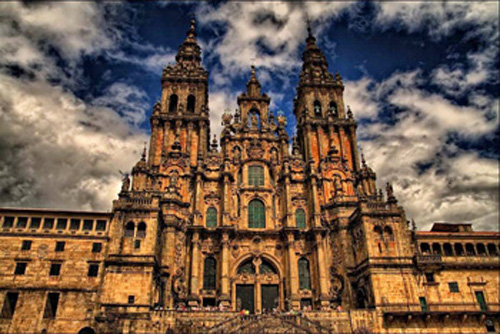
Santiago de Compostela
A few of St. James' disciples who had witnessed his martyrdom secretly took the body and carried it to a boat under cover of night. The disciples then immediately set sail without rudder or steersman, and the boat was miraculously guided to Spain by an Angel.
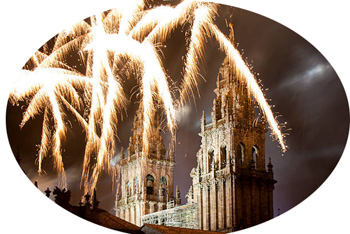
Fire falls like stars from Heaven over Santiago de Compostela on the eve of St. James Feast
In 819, a small church was built over the tomb. This church was later destroyed by the Muslims in the 10th century. Under the reign of Alfonso VI, construction of a new grand cathedral known as Santiago de Compostela began in 1060 and was completed in 1211. Over the years, new embellishments were added to make the Cathedral the marvel that it is today.
The pilgrim & the scallop shell
Santiago de Compostela became one of the most visited pilgrimage sites in the Middle Ages, surpassed only by Jerusalem and Rome. Pilgrims who end their journey on July 25, St. James' Day, are given special indulgences.
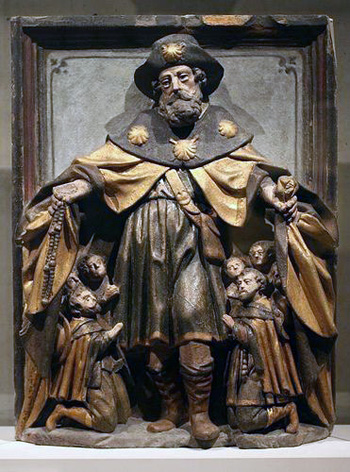
St. James with his shell emblems & devotees
Compostela's location near the ocean made it an area rich in scallop shells, which pilgrims collected as an emblem of their arduous journey. For this reason, the scallop shell became an ensign of St. James and an integral part of the pilgrim's garb. Pilgrims proudly wore scallop or cockleshells on their hats or cloaks.
An old legend recounts how this custom began. As the relics of St. James were miraculously sailing over the sea, a Portuguese knight was thrown into the sea when his horse lost its footing after beholding the astonishing sight. The disciples in the boat rescued the knight, and gazed in wonder at his soaked garment, which was covered with scallop shells. (2)
Oysters & shells on St. James Day
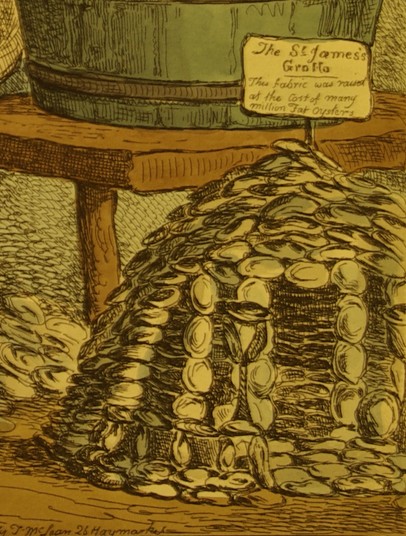
The oyster grotto provides alms for the poor
The Spanish also eat a dishes of oysters or scallops on this day in order to ensure prosperity in the coming year. In France, scallops are called coquilles St. Jacques ("St. James cockles") and are served with a cream sauce in a scallop shell.
A week before the feast day, the poor children of London collected cockleshells and oyster shells from fish shops and taverns. With these shells, the children built small grottos, often decorating them with marigolds and placing candles inside. They begged passersby for a pence in exchange for a large shell, saying "Please to remember the grotto." (4)
This custom is believed to be from the Middle Ages, for these grottos would give the faithful who could not go on the pilgrimage to Compostela a chance to honor St. James by giving an alms to the poor.
Grand ceremonies & joyful festivities in Spain
At midnight on the Eve of St. James Day, Spain's Cathedral bells toll to announce the arrival of the great feast. As the bells toll, the grand firework display known as La Fachada lights up Compostela, calling to memory the "field of stars" that guided the hermit to the Saint's tomb more than a thousand years ago.
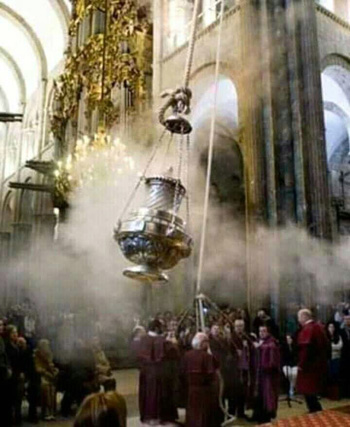
The enormous Botafumero swings through the aisles
According to local legend of the Catalan city of Lleida, when St. James stepped on the shore of Catalonia on a dark night, he stepped on a thorn. An Angel miraculously appeared with a lantern to help him remove the thorn. In honor of this miracle, every year the people processed with a statue of the Saint on the eve of the feast day, carrying lanterns to accompany him. (6)
The celebrations are especially grand in the city Santiago de Compostela where they are prolonged for two weeks with solemn processions, bullfights, singing, Galician bag-piping and feasting.
On the feast day, a magnificent procession goes around the Cathedral led by the Archbishop and followed by the Knights of the Order of Santiago. The High Mass that follows is attended by members of the Spanish Royal Family, who traditionally make a generous offering to St. James.
During the Mass, the famous Botafumero, the six-and-a-half-foot tall thurible, is swung through the aisles accompanied by the sound of chirimias (long silver flutes perhaps of Moorish origin).
In the New World
The Spanish colonists brought the customs of St. James feast day to Puerto Rico, and it soon developed distinct African and island customs. They celebrated with colorful parades, dances and music that are continued to this day.
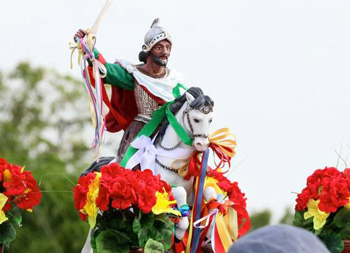
Santiago de los Muchachos is born triumphantly in procession; below, Los Vejigantes depicting devils, Moors & evil
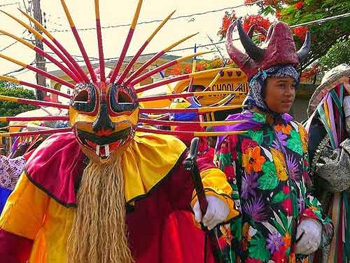
On July 26, the statue known as "St. James of the Men" (Santiago de los Hombres) is carried on a litter in a colorful procession led by the mantenedor who carries a flag with St. James' emblem.
Along the route, the procession stops in front of the house where the statue known as "St. James of the Children" (Santiago de los Muchachos) is kept. On arrival, several rockets are fired to salute the new statue. Then, the litter bearing Santiago de los Muchachos is carried to Santiago de los Hombres, and both statues are lowered three times in a sign of salutation before the procession continues.
A third stop is made in front of the chapel containing the statue of Santiago de las Mujeres. The rocket salutes are repeated, and this time all three statues are lowered. The procession continues to a place by the seashore called Las Carreras and halts before an ancient rubber tree where Santiago de los Muchachos was miraculously discovered hundreds of years ago.
Then, the traditional "running with the flags" in honor of St. James commences. Masqueraders dressed as Los Caballeros race on horseback bearing the flag of one of the statues. A second procession brings the statues back to their homes and ends the day. The next two days have two more processions that honor each of the other two statues in like manner as the first.
The colorful processions have four traditional groups of masqueraders who accompany the statue. Los Caballeros portray the Spanish knights with their green, red or yellow capes and metal knight's helmets accented with ribbons, bells and mirrors in an authentic mixture of African and Spanish vitality.
These noble knights enter into mock combat with their mortal enemies, Los Vejigantes, who wear frightening masks with horns and sharp teeth constructed from island coconut shells. These characters represent devils, the Moors and evil.
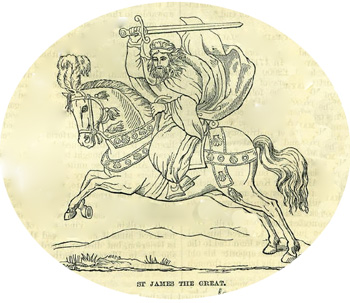
St. James the Moor-slayer
In New Mexico, the Indian pueblos evangelized by Spanish missionaries celebrated this feast day with the Fiestas de Santiago y Santa Ana, which included not only St. James, but also St. Anne whose feast follows on July 26. The Indians performed the corn dance to honor the two beloved saints.(8)
It is beautiful to see how Spain brought her good customs to the countries that it evangelized, inspiring the people to enrich them with their own unique spirit, a good example of how every people develops its way to understand God and the Saints.
Lest these customs be forgotten and abandoned, it would be fitting to make some tribute to St. James on his Feast Day, restoring the old customs as far as we are able, such as having processions, eating oysters or scallops, building shell grottos or initiating festive celebrations. Thus will due homage be made to the great Saint who has inspired pilgrims and warriors alike in the quest for God.
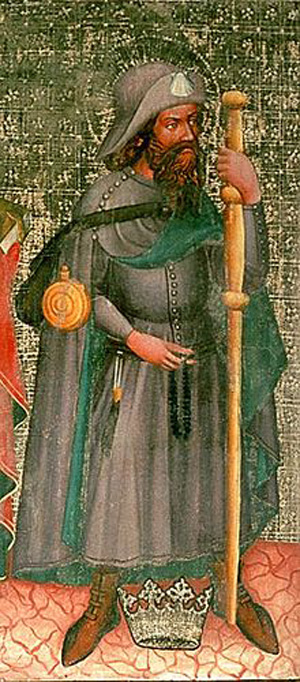
A medieval pilgrim
- "Everything You Need to Know About the Apostle St. James the Greater," Follow the Camino, April 27, 2018.
- "July 25th," Hillman's Hyperlinked and Searchable Chambers' Book of Days, Emmitsburg.net, accessed July 22, 2021.
- Steve Roud. The English Year (Penguin Books: 2006), 247, 258-259.
- Katherine Burton and Helmut Ripperger, Feast Day Cookbook (Catholic Authors Press, 2005), p. 95.
- Nina Epton. Spanish Fiestas (Cranbury, New Jersey: A. S. Barnes and Company, 1969), pp. 151-154.
- The Way of Saint James," Catalunya, Agència Catalana de Turisme, accessed July 22, 2021.
- Ricardo E. Alegría. "The Fiesta of Santiago Apostol (St. James the Apostle) in Loíza, Puerto Rico." (The Journal of American Folklore 69, no. 272, 1956), pp. 123-134.
- "St. James's Day," The Free Dictionary, Farlex, accessed July 22, 2021.

Posted July 23, 2021
______________________
______________________
 |
 |
 |
 |
 |
 |


